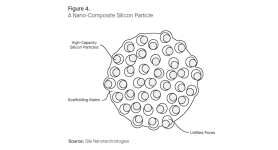speedmd
10 MW
Wonder what the hair pin motors will be like? Sandy Monro spotted 24 fet controllers in the prototype area. Claims the hair pin design could be as much as a 30% power bump.If things got as drastic as being limited to 700hp,
Wonder what the hair pin motors will be like? Sandy Monro spotted 24 fet controllers in the prototype area. Claims the hair pin design could be as much as a 30% power bump.If things got as drastic as being limited to 700hp,
the guy sounds like ArnoldWho's up for some fresh new quality battery porn!?
On the topic of Sany Monro, here is his latest video discussing Lithium Sulfur with Zeta Energy.
Looks like this lithium-sulphur battery technology is set to blow away traditional lithium-ion and even make it cheaper at the same time by using cheaper more abundant materials and smarter manufacturing methods, they even have a fast process of growing their own nanotubes.
I don't know why but I thought lithium-sulfur was the dodgiest looking until I watched this video and it totally flipped my opinion of it to excited and expecting to see it soon, which is far more than what I can say about anything else.


A few more details I found on the Amprius cells:

500 When Energy Density Report
amprius.com
Looks like they are fairly safe too:
Powerful Battery Cell Nails Military Safety Test
Powerful Battery Cell Nails Military Safety Testwww.nationaldefensemagazine.org
I have not found anything about lifecycle tests.
Good point and thanks for the clarification.Well, the battery pack's weight isn't even nearly all cell weight, so it wouldn't cut it in half.
500Wh/kg at C/10 !Twice the energy density of Li-Ion 2170.
If a battery pack in a Tesla 3 series weights 1300 lbs, can one imagine cutting vehicle weight by 650 lbs for even greater range due to reduced vehicle weight? Incredible and exciting.
Hillhater, do you have the Wh/kg for a Tesla 21700 pack or you going off middle of the road 21700, more generic cells in your assessment?500Wh/kg at C/10 !
380 Wh/kg at C/5…. With burst ability of 6C
so more like <50% better energy density than 2170 …for a useful traction pack.
…Very good, but not incredible.
 cleantechnica.com
cleantechnica.com
Great info Hillhater, thanks.Not “pack” data, but cell level info is available ..18Wh and 67.5 gms for the tesla 2170..= 266 Wh/kg.
also “Clean Technica” reported this..
”The Tesla Model 3 pack weighs 1,054 lb (480 kg), giving the pack gravimetric density of 168 Wh/kg. Essentially, the pack energy is the same as the heavier (1,300 lb) Model S P85 pack….….There are 4,416 cells in a 46p, 96s arrangement”
So that implies 298 kg of actual cells, and 182kg of. “ other stuff”. to complete the pack
so cells make up 62% of the total pack weight.
Tesla Model 3 & Chevy Bolt Battery Packs Examined - CleanTechnica
Since the Tesla Model 3 and Chevy Bolt were introduced, there has been considerable interest in the heart of their performance, the battery packs. These two cars have been pivotal in introducing lower-cost long-range electric transport.cleantechnica.com

I think you mean Wh/kg not Wh/Liter, as many commercial cells are >700Wh/liter.260 Wh/L is about best commercially available in the 18650 or 21700 cells.
Luke, are any of those auto (EV ?) cells compact enough for ebikes ?I think you mean Wh/kg not Wh/Liter,

 cnevpost.com
cnevpost.com
